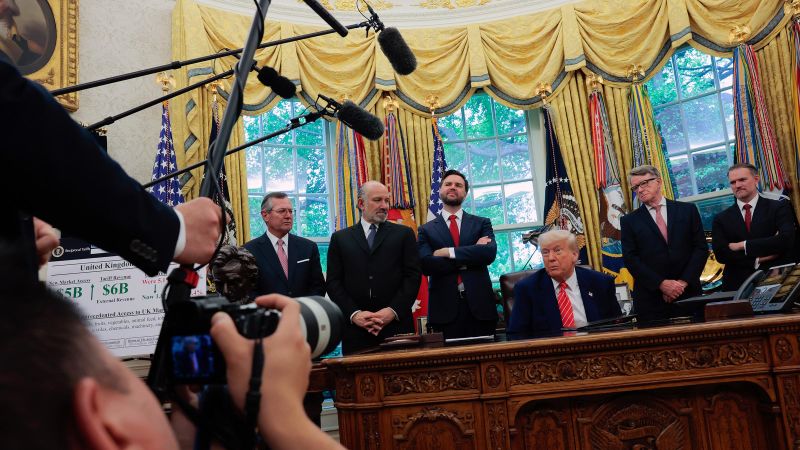New York
CNN
—
Stacey Wales spent two years working on the victim impact statement she planned to give in court after her brother was shot to death in a 2021 road rage incident. But even after all that time, Wales felt her statement wouldn’t be enough to capture her brother Christopher Pelkey’s humanity and what he would’ve wanted to say.
So, Wales decided to let Pelkey give the statement himself — with the help of artificial intelligence.
She and her husband created an AI-generated video version of Pelkey to play during his killer’s sentencing hearing earlier this month that read, in a recreation of Pelkey’s own voice, a script that Wales wrote. In it, the AI version of Pelkey expressed forgiveness to the shooter, something Wales said she knew her brother would have done but she wasn’t ready to do herself just yet.
“The only thing that kept entering my head that I kept hearing was Chris and what he would say,” Wales told CNN. “I had to very carefully detach myself in order to write this on behalf of Chris because what he was saying is not necessarily what I believe, but I know it’s what he would think.”
AI is increasingly playing a role in legal and criminal justice processes, although this is believed to be the first time AI has been used to recreate a victim for their own impact statement. And experts say the world will increasingly have to grapple with ethical and practical questions about the use of AI to replicate deceased people — both inside courtrooms and beyond them — as the technology becomes more human-like.
“We’ve all heard the expression, ‘seeing is believing, hearing is believing,’” said Paul Grimm, a Duke University School of Law professor and former district court judge in Maryland. “These kinds of technologies have tremendous impact to persuade and influence, and we’re always going to have to be balancing whether or not it is distorting the record upon which the jury or the judge has to decide in a way that makes it an unfair advantage for one side or the other.”
Judge Todd Lang of Maricopa County Superior Court ultimately sentenced Pelkey’s killer Gabriel Paul Horcasitas to 10.5 years for manslaughter — although the state had asked for only 9.5 years — and 12.5 years in total, including an endangerment charge.
“I love that AI. Thank you for that,” Lang said, a recording of the hearing shows. “As angry as you are and justifiably angry as the family is, I heard the forgiveness.”
Pelkey’s story was previously reported by ABC15 Arizona.
Pelkey was the youngest of three children, a veteran and, according to Wales, “the most forgiving and the friendliest” member of the family. He was killed in November 2021 in Chandler, Arizona at the age of 37.
Pelkey’s autopsy photos and surveillance video of his death were shown during the trial, Wales said. But after a jury found Horcasitas guilty of reckless manslaughter, Wales wanted the judge to see what Pelkey was like when he was alive during the sentencing hearing.
Wales and her husband, Tim Wales, work in tech — she said they’d previously created AI video replicas of former CEOs and founders to speak at company conferences — so they decided in the weeks leading up to the sentencing hearing to try replicating Pelkey the same way.

They used several software platforms, trained on photos and an old video of Pelkey, to create the AI replica that was shown in the hearing on May 1. And on the day before the sentencing hearing, Wales called her lawyer, Jessica Gattuso, to get her blessing for the plan.
“I was concerned, I thought we would get an objection or some kind of pushback … I did what research I could, but I didn’t find anything because I’ve never heard of this being done,” Gattuso told CNN, adding that she ultimately relied on an Arizona law that gives victims discretion in how to deliver their statement.
Like other AI videos depicting people, the recreation of Pelkey is somewhat halting and awkward and starts with an acknowledgement that it was made using the technology. But Wales said she believes it captured his essence.
“It is a shame we encountered each other that day in those circumstances,” the AI version of Pelkey said in the video. “In another life, we probably could have been friends.”
Horcasitas’s lawyer, Jason Lamm, said the defense did not receive advance notice that AI would be used in a victim impact statement. He added: “It appears that the judge gave some weight to the AI video and that is an issue that will likely be pursued on appeal.”
Judges are increasingly facing decisions about AI’s role in the courtroom — including whether it should have one at all.
In a separate case in New York last month, an appellate judge quickly shut down an attempt by a plaintiff to have an AI-generated avatar argue his case, without first clarifying that it was not a real person. And just last week, a federal judicial panel advanced a draft rule that would require AI-generated evidence to meet the same reliability standards as evidence from human expert witnesses, according to a Reuters report.
AI’s advancement has also raised questions about whether the technology could replace human jobs in the legal field.
“It’s not going away, and we’re going to see more instances of this,” said Grimm, who was not involved with the Pelkey case. “Judges tend to be a little nervous about this technology, and so we’ll probably see initially more nos than yeses.”
Judges may be especially hesitant to allow AI-generated evidence or visual aids to be presented to a jury, which, unlike a judge in a sentencing case, hasn’t been trained not to let emotion overwhelm the facts of the case, Grimm said. There are also questions around whether AI could inaccurately represent a party to a case, for example, by making them appear more sympathetic.
Grimm suggested that, going forward, opposing counsel be given the chance to view AI-generated content and raise potential objections for a judge to review, before it gets shown in court.
Even Wales cautioned the technology should be used carefully.
“This was not evidence, the jury never saw this. It wasn’t even made before a verdict came down of guilty,” Wales said. “This is an opinion. And the judge was allowed to see a human that’s no longer here for who he was.”
Ultimately, she said, replicating her brother with AI was “healing” for her family. After it played in court, she said her 14-year-old son told her: “Thank you so much for making that. I needed to see and hear from Uncle Chris one more time.”
–CNN’s Hazel Tang contributed to this report.
Correction: A previous version of this story misstated the name of Stacey Wales’ husband, Tim Wales.
























